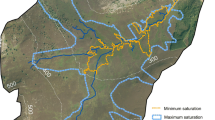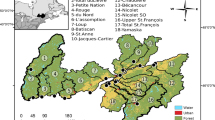Abstract
Short-term variability in stream water dissolved organic carbon (DOC) concentrations is controlled by hydrology, climate and atmospheric deposition. Using the Riparian flow-concentration Integration Model (RIM), we evaluated factors controlling stream water DOC in the Swedish Integrated Monitoring (IM) catchments by separating out hydrological effects on stream DOC dynamics. Model residuals were correlated with climate and deposition-related drivers. DOC was most strongly correlated to water flow in the northern catchment (Gammtratten). The southern Aneboda and Kindla catchments had pronounced seasonal DOC signals, which correlated weakly to flow. DOC concentrations at Gårdsjön increased, potentially in response to declining acid deposition. Soil temperature correlated strongly with model residuals at all sites. Incorporating soil temperature in RIM improved model performance substantially (20–62% lower median absolute error). According to the simulations, the RIM conceptualization of riparian processes explains between 36% (Kindla) and 61% (Aneboda) of the DOC dynamics at the IM sites.



Similar content being viewed by others
References
Ågren, A., M. Haei, S.J. Köhler, K. Bishop, and H. Laudon. 2010. Regulation of stream water dissolved organic carbon (DOC) concentrations during snowmelt; the role of discharge, winter climate and memory effects. Biogeosciences 7: 2901–2913.
Bertilsson, S., and L.J. Tranvik. 2000. Photochemical transformation of dissolved organic matter in lakes. Limnology and Oceanography 45: 753–762.
Beven, K.J. 2006. A manifesto for the equifinality thesis. Journal of Hydrology 320: 18–36.
Beven, K.J. 2007. Towards integrated environmental models of everywhere: Uncertainty, data and modelling as a learning process. Hydrology and Earth System Sciences 11: 460–467.
Beven, K.J. 2009. Environmental modelling: An uncertain future? Abingdon: Routledge.
Beven, K.J. 2010. Preferential flows and travel time distributions: Defining adequate hypothesis tests for hydrological process models. Hydrological Processes 24: 1537–1547.
Beven, K.J., and A. Binley. 1992. The future of distributed models: Model calibration and uncertainty prediction. Hydrological Processes 6: 279–298.
Bishop, K., J. Seibert, S. Köhler, and H. Laudon. 2004. Resolving the Double Paradox of rapidly mobilized old water with highly variable responses in runoff chemistry. Hydrological Processes 18: 185–189.
Christ, M.J., and M.B. David. 1996. Temperature and moisture effects on the production of dissolved organic carbon in a Spodosol. Soil Biology and Biochemistry 28: 1191–1199.
Clark, J.M., P.J. Chapman, J.K. Adamson, and S.N. Lane. 2005. Influence of drought-induced acidification on the mobility of dissolved organic carbon in peat soils. Global Change Biology 11: 791–809.
Cole, J.J., Y.T. Prairie, N.F. Caraco, W.H. McDowell, L.J. Tranvik, R.G. Striegl, C.M. Duarte, P. Kortelainen, et al. 2007. Plumbing the global carbon cycle: Integrating inland waters into the terrestrial carbon budget. Ecosystems 10: 171–184.
Davidson, E.A., and I.A. Janssens. 2006. Temperature sensitivity of soil carbon decomposition and feedbacks to climate change. Nature 440: 165–173.
Davidson, E.A., I.A. Janssens, and Y. Luo. 2006. On the variability of respiration in terrestrial ecosystems: Moving beyond Q10. Global Change Biology 12: 154–164.
Driscoll, C.T., K.M. Driscoll, K.M. Roy, and M.J. Mitchell. 2003. Chemical response of lakes in the Adirondack region of New York to declines in acidic deposition. Environmental Science and Technology 37: 2036–2042.
Eimers, M.C., J. Buttle, and S.A. Watmough. 2008. Influence of seasonal changes in runoff and extreme events on dissolved organic carbon trends in wetland- and upland-draining streams. Canadian Journal of Fisheries and Aquatic Sciences 65: 796–808. doi:10.1139/f07-194.
Eriksson, L., J.L.M. Hermens, E. Johansson, H.J.M. Verhaar, and S. Wold. 1995. Multivariate-analysis of aquatic toxicity data with PLS. Aquatic Sciences 57: 217–241.
Evans, C.D., P.J. Chapman, J.M. Clark, D.T. Monteith, and M.S. Cresser. 2006. Alternative explanations for rising dissolved organic carbon export from organic soils. Global Change Biology 12: 2044–2053. doi:10.1111/j.1365-2486.2006.01241.x.
Evans, C., C. Goodale, S. Caporn, N. Dise, B. Emmett, I. Fernandez, C. Field, S. Findlay, et al. 2008. Does elevated nitrogen deposition or ecosystem recovery from acidification drive increased dissolved organic carbon loss from upland soil? A review of evidence from field nitrogen addition experiments. Biogeochemistry 91: 13–35.
Evans, C.D., D.T. Monteith, and D.M. Cooper. 2005. Long-term increases in surface water dissolved organic carbon: Observations, possible causes and environmental impacts. Environmental Pollution 137: 55–71.
Fölster, J. 2001. Significance of processes in the near-stream zone on stream water acidity in a small acidified forested catchment. Hydrological Processes 15: 201–217.
Gadmar, T.C., R.D. Vogt, and B. Osterhus. 2002. The merits of the high-temperature combustion method for determining the amount of natural organic carbon in surface freshwater samples. International Journal of Environmental Analytical Chemistry 82: 451–461. doi:10.1080/0306791021000018099.
Geladi, P., and B.R. Kowalski. 1986. Partial least-squares regression—A tutorial. Analytica Chimica Acta 185: 1–17.
Giesler, R., M. Högberg, B. Strobel, A. Richter, A. Nordgren, and P. Högberg. 2007. Production of dissolved organic carbon and low-molecular weight organic acids in soil solution driven by recent tree photosynthate. Biogeochemistry 84: 1–12.
Godsey, S.E., J.W. Kirchner, and D.W. Clow. 2009. Concentration–discharge relationships reflect chemostatic characteristics of US catchments. Hydrological Processes 23: 1844–1864.
Grabs, T. 2010. Water quality modeling based on landscape analysis: Importance of riparian hydrology. Stockholm: Department of Physical Geography and Quaternary Geology (INK), Stockholm University.
Hinton, M.J., S.L. Schiff, and M.C. English. 1998. Sources and flowpaths of dissolved organic carbon during storms in two forested watersheds of the Precambrian Shield. Biogeochemistry 41: 175–197.
Hirsch, R.M., and J.R. Slack. 1984. A nonparametric trend test for seasonal data with serial dependence. Water Resources Research 20: 727–732.
Hruska, J., P. Kram, W.H. McDowell, and F. Oulehle. 2009. Increased dissolved organic carbon (DOC) in Central European streams is driven by reductions in ionic strength rather than climate change or decreasing acidity. Environmental Science and Technology 43: 4320–4326.
Kalbitz, K., S. Solinger, J.H. Park, B. Michalzik, and E. Matzner. 2000. Controls on the dynamics of dissolved organic matter in soils: A review. Soil Science 165: 277–304.
Köhler, S., I. Buffam, A. Jonsson, and K. Bishop. 2002. Photochemical and microbial processing of stream and soil water dissolved organic matter in a boreal forested catchment in northern Sweden. Aquatic Sciences 64: 269–281.
Köhler, S.J., I. Buffam, J. Seibert, K.H. Bishop, and H. Laudon. 2009. Dynamics of stream water TOC concentrations in a boreal headwater catchment: Controlling factors and implications for climate scenarios. Journal of Hydrology 373: 44–56.
Laudon, H., S. Köhler, and I. Buffam. 2004. Seasonal TOC export from seven boreal catchments in northern Sweden. Aquatic Sciences 66: 223–230.
Löfgren, S., M. Aastrup, L. Bringmark, H. Hultberg, L. Lewin-Pihlblad, L. Lundin, G. Pihl Karlsson, and B. Thunholm. 2011. Recovery from acidification in soil water, groundwater and surface water at the Swedish integrated monitoring sites. Ambio. doi:10.1007/s13280-011-0207-8.
Löfgren, S., and N. Cory. 2010. Groundwater Al dynamics in boreal hillslopes at three integrated monitoring sites along a sulphur deposition gradient in Sweden. Journal of Hydrology 380: 289–297. doi:10.1016/j.jhydrol.2009.11.004.
Löfgren, S., J.P. Gustafsson, and L. Bringmark. 2010. Decreasing DOC trends in soil solution along the hillslopes at two IM sites in southern Sweden—Geochemical modeling of organic matter solubility during acidification recovery. Science of the Total Environment 409: 201–210.
Löfgren, S., and T. Zetterberg. 2011. Decreased DOC concentrations in soil water in forested areas in southern Sweden during 1987–2008. Science of the Total Environment 409: 1916–1926.
Lundin, L., M. Aastrup, L. Bringmark, S. Bråkenhielm, H. Hultberg, K. Johansson, K. Kindbom, H. Kvarnäs, et al. 2001. Impacts from deposition on Swedish forest ecosystems identified by integrated monitoring. Water, Air, and Soil pollution 130: 1031–1036.
Moldan, F., J. Hruška, C. Evans, and M. Hauhs. 2011. Experimental simulation of the effects of extreme climatic events on major ions, acidity and dissolved organic carbon leaching from a forested catchment, Gårdsjön, Sweden. Biogeochemistry. doi:10.1007/s10533-010-9567-6.
Moldan, F., and R.F. Wright. 1998. Episodic behaviour of nitrate in runoff during six years of nitrogen addition to the NITREX catchment at Gardsjon, Sweden. Environmental Pollution 102: 439–444.
Monteith, D.T., J.L. Stoddard, C.D. Evans, H.A. de Wit, M. Forsius, T. Hogasen, A. Wilander, B.L. Skjelkvale, et al. 2007. Dissolved organic carbon trends resulting from changes in atmospheric deposition chemistry. Nature 450: 537–540.
Nash, J.E., and J.V. Sutcliffe. 1970. River flow forecasting through conceptual models, part I—A discussion of principles. Journal of Hydrology 10: 282–290.
Nyberg, L., M. Stähli, P.-E. Mellander, and K.H. Bishop. 2001. Soil frost effects on soil water and runoff dynamics along a boreal forest transect: 1. Field investigations. Hydrological Processes 15: 909–926.
Raymond, P., and J. Saiers. 2010. Event controlled DOC export from forested watersheds. Biogeochemistry 100: 197–209.
Schulten, H.R., and M. Schnitzer. 1993. A state of the art structural concept for humic substances. Naturwissenschaften 80: 29–30.
Seibert, J., K. Bishop, A. Rodhe, and J.J. McDonnell. 2003. Groundwater dynamics along a hillslope: A test of the steady state hypothesis. Water Resources Research 39. doi:10.1029/2002wr001404.
Seibert, J., T. Grabs, S. Köhler, H. Laudon, M. Winterdahl, and K. Bishop. 2009. Linking soil- and stream-water chemistry based on a Riparian flow-concentration integration model. Hydrology and Earth System Sciences 13: 2287–2297.
Seibert, J., and J.J. McDonnell. 2002. On the dialog between experimentalist and modeler in catchment hydrology: Use of soft data for multicriteria model calibration. Water Resour. Res. 38: 1241. doi:10.1029/2001WR000978.
Swedish University of Agricultural Sciences. 2011. Analytical methods for water chemistry (in Swedish). http://www.slu.se/vatten-miljo/vattenanalyser. Retrieved 14 Sep 2011.
Tipping, E., M. Billett, C. Bryant, S. Buckingham, and S. Thacker. 2010. Sources and ages of dissolved organic matter in peatland streams: Evidence from chemistry mixture modelling and radiocarbon data. Biogeochemistry 100: 121–137.
Winterdahl, M., M.N. Futter, S. Köhler, H. Laudon, J. Seibert, and K. Bishop. 2011. Riparian soil temperature modification of the relationship between flow and dissolved organic carbon concentration in a boreal stream. Water Resources Research 47: W08532. doi:10.1029/2010WR010235.
Acknowledgments
The Swedish Integrated Monitoring program has been funded by the Swedish Environmental Protection Agency. This work would not have been possible without the efforts of all the people who collected and analyzed samples from the IM sites, and those who maintained the data archive. MNF was funded by the Mistra FutureForests programme. Financial support for JT was provided by the Swedish Environmental Protection Agency programme CLEO, the Swedish University of Agricultural Sciences and the Swedish Meteorological and Hydrological Institute.
Author information
Authors and Affiliations
Corresponding author
Rights and permissions
About this article
Cite this article
Winterdahl, M., Temnerud, J., Futter, M.N. et al. Riparian Zone Influence on Stream Water Dissolved Organic Carbon Concentrations at the Swedish Integrated Monitoring Sites. AMBIO 40, 920–930 (2011). https://doi.org/10.1007/s13280-011-0199-4
Published:
Issue Date:
DOI: https://doi.org/10.1007/s13280-011-0199-4




